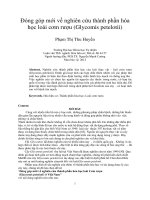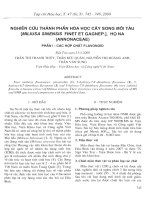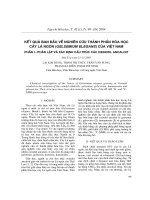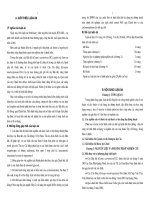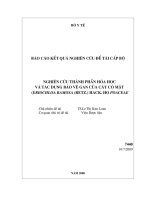Đóng góp mới về nghiên cứu thành phần hóa học loài cơm rượu (glycomis petelotii)
Bạn đang xem bản rút gọn của tài liệu. Xem và tải ngay bản đầy đủ của tài liệu tại đây (469.42 KB, 14 trang )
1
i v
hu (Glycomis petelotii)
Phm Th Thu Huyn
i hc Khoa hc T
Lu ThS. ; : 60 44 27
ng dn: PGS.TS. Nguyn Mng
o v: 2012
Abstract. hc c c vt - u
p ch
sinh h hing cha bnh tim m
.
Vi n lc ngu c
quc t trong ving sinh h sinh hc hii.
,
.
Keywords. ; a hc; u
Content
MỞ ĐẦU
,
,
.
t kho thuc khng l v
t. Do nh
hu, o
mt h ng thc v. Theo s
liu tht Vic 307 h thc vm
c s dc cha b [83]. Nguc v
thuy mng dc.
tin ph
.
Chi Glycosmis
, .
,
,
.
CGlycosmis petelotii i Viu t [50]. Qua
hong mch chut thc nghi
MeOH Glycosmis petelotii ng cao,
.
Glycosmis petelotii.
Nhm mu v ha
a ch
"Đo
́
ng go
́
p mơ
́
i vê
̀
nghiên cư
́
u tha
̀
nh phâ
̀
n ho
́
a ho
̣
c loa
̀
i Cơm rươ
̣
u
(Glycosmis petelotii) ở Việt Nam''
vi n
2
1. c ca thc v
2. p ch sinh h t hin
ng cha bnh tim mch .
Vihn lc nguc t
trong ving sinh h sinh hc hin i.
, ,
. Luc nhiu kt qu
mc tin cao.
THỰC NGHIỆM
1.1. Đối tượng
Mi rng Cc Pc th, Vit
nh bc vt hi- Vin
c liu. Mn s C-i Vip chn
Khoa h Vit Nam. Mu ly v c ra sch, loi b n
y nhi 40
0
n nh ng bt, bo qu
n nh
nhi
t lt b hexan, chlo
cn ching.
chiy s
khan, lt lc khi s dng.
Cc cp chp nh bt h
c, s d khng (ESI-
MS), ph khi cao (HR-ESI-MS), ph cng t ht chi
chiu (1D, 2D-NMR).
ch
1.2. Xử lý mẫu thực vật và chiết tách
/3) G. petelotii ghin nh t vi
35 nhi t trong n cn metanol (1,27 kg)
n MeOH - H
2
O (t l 1 : 1) vt lt b
theo th t n nhexan, cSau khi ct
lot gin chit
i.
1.3. Hằng số vật lý và các dữ kiện phổ của các hợp chất phân lập được
Hằng số vật lý và các dữ kiện phổ của hợp chất MC-340
MC 340 (cht mi)
Tng: Demethylglypetelotine
TS-methyl N,N-2-[(1H)-indol-3-ethyl]-thiocarbamate,
CTPT: C
12
H
14
N
2
OS
Tinh th c trong clorofom, axeton.
Ph
1
H-NMR (Axeton-d
6
, 500 MHz), (ppm): 10,02 (1H; s; H-1); 7,60 (1H; d; 8,0
Hz; H-4); 7,38 (1H; d; 8,5 Hz; H-7); 7,29 (1H; br.s; H--2); 7,09 (1H; t;
7,5 Hz; H-6); 7,02 (1H; t; 7,5 Hz; H-5); 3,55 (2H; dt; 6,5; 6,5 Hz; H-
H--
Ph
13
C-NMR (Axeton-d
6
, 125 MHz) (ppm): 167 (s; C- u); 137,7 (s; C-8);
128,5 (s; C-9); 123,4 (d; C-2); 122,1 (d; C-6); 119,4 (d; C-5); 119,2 (d; C-4); 113,1 (s; C-3);
112,1 (d; C-7); 42,7 (t; C---
Ph HR-ESI-MS: 235,09017 ([M+H]
+
); 187,08677 ([M+H-CH
3
SH]
+
)
3
: 3420,99 cm
-1
N H
(
: N
,
-1
=CH ( )
, 1678 cm
-1
C=O
, 1590 cm
-1
NH ( )
, 1467 cm
-1
CH
, 1104
cm
-1
CO S
, 730 cm
-1
C S
, 2222,72 cm
-1
Hằng số vật lý và các dữ kiện phổ của hợp chất MC-339 ( trng MC-308)
MC-339 (-308):
: glypetelotine
S-methyl N,N-2-[(1H)-indol-3-ethyl]-methyl-thiocarbamate,
CTPT: C
13
H
16
N
2
OS
Tinh th c trong
clorofom, axeton.
Ph ESI-MS (+): 272.1 ([M+Na]
+
); HR-ESI-MS (+): 272.09019 ([M+Na]
+
),
201.10204 ([M-CH
3
SH]
+
).
Ph
1
H-NMR (Axeton-d
6
, 500 MHz), (ppm): 10,05 (1H; s; H-1); 7,67 (1H; d; 7,5
Hz; H-4); 7,39 (1H; d; 8,0 Hz; H-7); 7,19 (1H; br.s; H-2); 7,11 (1H; t; 7,5 Hz; H-6); 7,04
(1H; t; 7,5 Hz; H-5); 3,66 (2H; br.d; H---
Ph
13
C-NMR (Axeton-d
6
, 125 MHz) (ppm): 168.2 (s; C--8); 128,5
(s; C-9); 123,4 (d; C-2); 122,2 (d; C-6); 119,5 (d; C-5); 119,2 (d; C-4); 112,8 (s; C-3); 112,2
(d; C-7); 51,1 (t; C---
Hằng số vật lý và các dữ kiện phổ của hợp chất GPH
1
GPH
1
CTPT: C
29
H
50
O
: -Sitosterol
IUPAC: 17-(5-Ethyl-6-methylheptan-2-yl)-10,13-dimethyl-
2,3,4,7,8,9,11,12,14,15,16,17-dodecahydro-1H-cyclopenta[a]phenanthren-3-ol.
, c trong metanol.
140 145
o
C
1
H NMR (500MHz, CDCl
3
) (ppm): 0,68 (3H; s; CH
3
-18); 1,01 (3H; s; CH
3
-
19); 0,81 (3H; d;7,7 Hz;CH
3
-26); 0,88 (3H;d; 7,7Hz; CH
3
-27); 0,84 (3H; t; 7,3 Hz; CH
3
-29);
0,92 (3H; d; 10Hz; CH
3
-21); 3,53 (1H; m; H-3); 5,35 (1H, d, 5,5 Hz, H -6 )
Hằng số vật lý và các dữ kiện phổ của hợp chất GPH
2
CTPT: C
18
H
34
O
2
: axit oleic
-9-octadecenoic
, , , tan trong n - Hexan.
13 14
o
C
1
H NMR ( 500 MHz, CDCl
3
) : (ppm): 0,88 (3H;t; CH
3
-18); 1,63 (2H; m; H -
17); 2,00 2,01 (2x2H; d; H-8 -11); 2,34 (2H; t; H-2); 5,34 (2H, m, H -9, H-10 )
KẾT QUẢ
T (Glycosmis petelotii)
GPH
1
( -Sitosterol) ,
GPH
2
( Axit oleic)
-Hexan, MC340
(DemethylGlypetelotine)
1 308 (MC339)
(Glypetelotine)
Hợp chất MC- 340 :
MC – 340
, xanh tan
c trong clorofom, axeton.
4
1-340
Vị trí
δ
C
(ppm)
δ
H
(ppm)
HMBC (HC)
ROESY
(HH)
1
10,02 (1H; s)
2
123,4 (d)
7,17 (1H; br.s)
C-3; C-8; C-9
3
113,1 (s)
4
119,2 (d)
7,60 (1H; d; 8,0 Hz)
C-3; C-6; C-8
H-6
5
119,4 (d)
7,02 (1H; t; 7,5 Hz)
C-7; C-9
6
122,1 (d)
7,09 (1H; t; 7,5 Hz)
C-4; C-8
H-4
7
112,1 (d)
7,38 (1H; d; 8,5 Hz)
C-5; C-9
8
137,7 (s)
9
128,5 (s)
1’
26,4 (t)
2,97 (2H; t; 7,5 Hz)
C-2; C-3; C-9; C-
H-
2’
42,7 (t)
3,56 (2H; dt; 6,5; 6,5 Hz)
C-3; C--
H-
3’
7,29 (1H; s)
4’
167 (s)
(yu)
5’
6’
11,9 (q)
2,27 (3H; s)
C-
(
) :
N
CH
2
CH
2
N
S
CH
3
O
H
H
H
H
H
H
H
1
2
3
4
5
6
7
8
9
1'
2'
3'
4'
5'
6'
2
:
5
N
CH
2
CH
2
N
S
CH
3
O
H
H
H
H
H
H
H
1
2
3
4
5
6
7
8
9
1'
2'
3'
4'
5'
6'
, h-340
, ,
: S-
methyl N,N-2-[(1H)-indol-3-ethyl]-thiocarbamate. H
Glycosmis petelotii.
: C
12
H
14
N
2
OS ( M = 234).
Hơ
̣
p châ
́
t MC – 339 (trng MC – 308):
MC 339 308
90%
1
13
C NMR. nh MC 308 339
1
c trong
clorofom, axeton.
-339 (308)
Vị
trí
δ
C
(ppm)
δ
H
(ppm)
HMBC
(HC)
COSY
(HH)
NOESY
(HH)
1
10,05 (1H; s)
H-2
2
123,4 (d)
7,19 (1H; br.s)
H--1
3
112.8 (s)
4
119,2 (d)
7,67 (1H; d; 7.5
Hz)
C-6; C-8; C-9
H-5
H-5, H--
5
119,5 (d)
7,04 (1H; t; 7,5
Hz)
C-7; C-9
H-4, H-6
H-4, H-6
6
122,2 (d)
7,11 (1H; t; 7,5
Hz)
C-4; C-8
H-5, H-7
H-5, H-7
7
112,2 (d)
7,39 (1H; d; 8,0
Hz)
C-5; C-9
H-6
H-6
8
137,7 (s)
9
128,5 (s)
1’
51.1 (t)
3.66 (2H; br.d)
H-2
H-4, H-2
2’
24.2 (t)
2.98 (2H; br.d)
C--4
H-1
H-2, H-4, H-1
3’
4’
168.2 (s)
5’
6’
12.8 (q)
2,29 (3H; s)
C-4
-
7’
35,2
2,88(3H; s)
C
-
6
+
, COSY, NOESY,
,
,
.
N
CH
2
H
2
C
N
S
H
3
C
CH
3
O
H
H
H
H
H
H
1
2
3
4
5
6
7
8
9
1
'
2
'
3
'
4
'
5
'
6
'
7
'
NH
CH
2
CH
2
N
S
CH
3
CH
3
O
H
H
H
H
H
1
2
3
4
5
6
7
8
9
1
'
2
'
3
'
4
'
5
'
6
'
7
'
NH
CH
2
CH
2
N
S
CH
3
CH
3
O
H
H
H
H
H
1
2
3
4
5
6
7
8
1
'
2
'
3
'
4
'
5
'
6
'
7
'
HMBC
COSY
NOESY
Kê
́
t luâ
̣
n:
308, MC340
Hơ
̣
p châ
́
t GPH
1
:
, ,
1
Sitosterol
-Hexan.
,
1
H NMR
Sitosterol (
)
Kê
́
t luâ
̣
n: GPH
1
Sitosterol :
HO
2
3
4
5
6
7
8
9
10
1
19
11
12
13
14
15
16
17
18
20
22
23
24
28
29
25
27
28
21
Hơ
̣
p châ
́
t GPH
2
:
, , ,
2
axit Oleic
-Hexan.
,
1
H
.
axit
oleic
Kê
́
t luâ
̣
n: GPH
2
axit oleic :
7
OH
O
Đánh giá hoạt tính sinh ho
̣
c dịch phân bố và dịch chiết của cây Glycosmis petelotii
1. Ảnh hưởng của các chất khảo sát tác dụng gây giãn mạch động mạch chuột đã loại bỏ
lớp tế bào nội mô (-EC) và gây co nhờ dung dịch K60
ng mch chut b loi b lp no co tht trong dung dch
PSS cha 60 mM KCl (K60) cho t cht th ng lic
u nh ng ca ch ng cong th hin nng
- phi
li m lp
li (mean e.s. (n = 4-7)).
.ang biu din s
mch ph thuc n cht th
ng mch chut loi lp t
nc
bng dung dch PSS cha 60mM KCl
(K60) (n 3-7).
Nhng hot chch chi
tr Emax c tip tc th
nng c ch 50%.
VIP 11 E
max
(%) ,
IC
50
.
.5.b th hin s ch
ph thuc n ct th
Emax ng mch chut loi lp t
c bng dung dch PSS cha 60mM KCl (K60) (n =4-7). Tt c t chch chit
th nghi IC
50
trong khong 13 63 g/ml.
0.1 1 10 100
0
50
100
05
[VIP] (g/ml)
10
14
13
11
12
23
16
03
06
Risposta (% di K60)
.5.b. ng biu din s ch ph thuc n ct th
ng mch chut loi lp t c bng
dung dch PSS cha 60mM KCl (K60) (n =4-7).
ch chit cu petelotii (Glycosmis petelotii Guillt).
Dch chi hin Emax ph
50
Effect of VIP on K60-induced contraction in rat aorta rings
0.1 1 10 100
0
50
100
VIP0007
VIP0008
VIP0017
VIP0001
VIP0004
VIP0018
VIP0019
VIP0020
VIP0024
VIP0027
VIP0026
VIP0002
VIP0025
VIP0021
VIP0028
VIP0015
VIP0022
VIP0029
VIP009
[drug] g/ml
Risposta (%)
8
Ảnh hưởng của các chất khảo sát tác dụng gây giãn mạch động mạch chuột đã loại bỏ
lớp tế bào nội mô (-EC) và gây co nhờ dung dịch phenylephrine
VIP11
nhng dch chich cao nhng mch
ch i b lp n t qu th
nghic H.c ng 3.3
0.1 1 10 100
0
50
100
[VIP] (g/ml)
10
11
14
06
Risposta (% di fenilefrina)
.c. ng biu din s ch ph thuc n ct th
ng mch chut loi lp t -c bng
(n =3- ng e.s. (n = 3-6). Ti
tr
Bng 3.3. ng ca dch chit VIP 11 loi b n-
p nbng phenylephrine
VIP
-EC
+EC
IC
50
(µg/ml)
E
max
IC
50
(µg/ml)
E
max
11
chit VIP 11 hiu qu ch cao, th hin
3.1
50
38.1
Ảnh hưởng của các dịch chiết khảo sát tác dụng gây giãn mạch động mạch chuột, còn
lớp tế bào nội mô (+EC) và gây co nhờ dung dịch phenylephrine
VIP11
nhng dch chich cao nhng mch
ch p vp t t qu th
nghi3.5.d ng 3.3.
0.1 1 10 100
0
50
100
[VIP] (g/ml)
10
06
11
14
Risposta (% di fenilefrina)
.d. ng biu din s ch ph thuc n ct th
ng mch chup t c bng
- ng e.s. (n = 3-6). Ti
tr
9
VIP11
nhng dch chich cao nhng mch
ch p v lp n t qu th
nghi Bng 2
50
.
Kt qu cho thy thuc lp t
endothelium cells.
Ảnh hưởng của phân đoạn từ dịch chiết tác dụng gây giãn mạch động mạch chuột, đã
loại bỏ lớp tế bào nội mô (-EC) và gây co nhờ dung dịch K60
t VIP11 m nhng dch chiu qu
nht trong s ch chit khch chit methanol tc tip tc
chin v -Hexane,
chloroform, ethylacet gim,
n ching VIP11H, VIP11C,
p tc th nghim hoch c
ng mch chung dung d
-ch ph thuc n ch chi
ng. Kt qu .e
1 10 100
0
50
100
[VIP] (g/ml)
11
11B
11C
11E
11H
11W
14
14B
14C
14E
14W
Risposta (% di K60)
3.5.e. ng biu din s ch ph thuc n cn
ng mch chut loi lp t -c bng
ng e.s. (n =1-2). Ti tri
K60
Kt qu cho thn chloroform ca dch chi ch
hiu qu nha, kh a dch chi
dch chit tng methanol VIP11.
Kt qu u su cho thy dch chit VIP11 t Glycosmis
petelotii ng mch chu i K60 hoc phenylephrine
thuc n
thuc n-independent vasodilato
d ng thuc ch
u
ch thun th (voltage-dependent Ca2+ channels
u khin th th (Receptor-m
n n t
Kết quả sàng lọc trên dòng ung thư gan ngươ
̀
i SK-Hep-1 và ung thư vú MCF-7
bic hot cht ch
MCF-7 (human breast adenocarcinoma)
SK-Hep-1 (human liver adenocarcinoma). Kt qu c
:
10
3.4--
Hep-Glypetelotine.
(CI -concentration inhibitory %)
Name
Origin
SK-Hep-1
cytotoxicity
(CI%)
MCF-7
cytotoxicity
ug/ml
CI%
ug/ml
CI%
glypetelotin
Glycosmis
petelotii
0.1
7.606
0.1
-1.71
1
9.975
1
-0.18
10
12.54
10
8.166
Kt qu cho th c ch 8-12% c hai loi ph.
Sàng lọc trên phép thử Wnt
hii nhc hot cht ch
u protein Wnt. Kt qu cho thy:
3.5
Stt
Code
Wnt signaling
21
VHKC-0021
0.35
: kt qu th cho thy m protein Wnt.
KÊ
́
T LUÂ
̣
N
(Glycosmis petelotii)
hai alkaloid
,
,
.
Sitosterol, Axit
oleic.
t kh ,
Glycosmis
petelotii , ng mch chui b lp t
n- dung dch K60; ng mch chui
b lp t - dung dch phenylephrine; ch
ng mch chup t dung dch phenylephrine
dng mch chui b lp t - dung
dch K60.
Glycosmis petelotii ,
Clorofom.
hot
ch chi
- gan (SK-Hep-1)
. Th s/b-catenin
signalling pathway.
11
References
Tài liệu tiếng Việt:
1. Tt Li (2001), Nh thuc Vit Nam, NXB y hc, i,
tr.142-143.
2. ng s ng vc Vit Nam,
NXB Khoa h thut, Tp 1, tr. 542.
3.
(2012), c
c m (Brucea mollis p (Glycosmis
stenocarpa (Drake) Guillaum) Vit Nam,
,
.
4. Nguyn M u
(Glycosmis petelotii Cinnamonmum balansae y
Carya tonkinensis Lecomte) Vit Nam, Luc, Vic.
5. Nguy Th u thuc c
p nhTp chc hc, s 8, tr. 5-7.
6. (2000),
,
2,
,
2, Tr. 1286.
7.
Tr. 1286.
Tài liệu tiê
́
ng Anh:
8. Arruda, M.S.P., Fernandes, J.B., Silva, M.F.D.G.F.D., Vieira, P.C., Pirani, J.R.,
1992, Quinolone alkaloids from Zanthoxylum actifolium, Phytochemistry 31, 36173619.
9. Bhattacharyya, J. and Pakrashi S.C (1979), The identity of glycophymine and
glycosminine: an alkaloid of Glycosmis arborea ( Roxb.) DC., Heterocyclea, 12, 929 31.
10. Bhattacharyya, P. and B.K., (19), Glycophylone: a new quinolone alkaloid from
Glycosmis pentaphylla, Chem. Ind. ( London), 9, 352.
11. Bhattacharyya, P., Sarkar, T., Chakraborty, A. and Chowdhury, B.K. (1984),
Structure and synthesis of Glycozoliol, a new carbazole alkaloid from Glycosmis pentaphylla
( Rez) DC., Indian J. Chem., Sect. B, 23B, 49 51.
12. Bhattacharyya, P. and Choudhury, B.K., (1985), J. Nat. Prod,48,465.
13. Bhattacharyya, P., Chakrabartty, P. K., and Chowdhury, B. K (1985), Glycozolidol, an
antibacterial carbazol alkaloid from Glycosmis pentaphylla, Phytochemistry, 24, 882-3.
14. Bhattacharyya, P., Chowdhury, B. K Glycolone, (1985), Glycozolidol, a quinolone
alkaloid from Glycosmis pentaphylla, Phytochemistry, 24, 634-5.
15. Bhattacharyya, P., Chowdhury, B.K., 1985. 2-Methoxy-3-methylcarbazole from
Murraya koenigii. Ind. J. Chem. Sect. B: Org. Chem. Incl. Med. Chem. 24B, 452.
16. Blatter C. (1975), Indian Medicinal Plants, Calcutta, 470.
17. Bovey, F, A. (1969), Nuclear Magbetic Resonance Spectrocopy, Academic Press,
New York, p. 122, 138, 159
18. Braulio M. Fraga (1998), Natural sesquiterpenoids, Nat. Prod. Rep., (1), 73-92.
19. Chakravarty, D. P. (1966), Glycozoline, a carbarzole derivative from Glycosmis
pentaphylla (retz) DC., Tetrahedron Letters, 6, 661 4.
20. Chakraborty, D. P. (1966), Science and Culture, 32, 181 2.
21. Chakravarty, A.K., Das, B., Masuda, K., and Ageta, H. (1996), Tetracyclic
triterpenoids from Glycosmis arborea, Phytochemistry, 42, 1109-13.
22. Chatterjee A. and Majumdar S. H. (1952), Science and Culture, 17, 306-307.
23. Chkravarti N., and Chakravarti S. C. (1952), J. Proc. Inst. Chemists (India), 4, 96-104.
24. Chou T. C., Tzeng C.C., Wu T. S., Watanabe K. A., Su T. L. (1989), Inhibition of cell
growth and marcromolecular biosynthesis of human promyelocytic leukemic cells by
acridone alkaloids, Phytotherapy Research, 3, 237-242.
12
25. Choudhury, B. K., Mustafa, A., Garba, M. and Bhattacharyya, P. (1988),
Phytochemistry, 26, 2138.
26. D. S. Bhakuni, N. C. Gupta, Sheo Satish, S.C. Sharma, Y. N. Shukla and J. S. Tandon
(1971), Chemical constituents off Actinodapne augustfolia, Croton sparsiflorus, Duabanga
sonneratiodes, Duabanga sonneratiodes, Glycosmis mauritiana, Hedyotis auricularia,
Lyonia ovalifolia, Micromelum pubescens, Pyrus pashia and Rhododendron niveum,
Phytochemistry, 10(9), 2247 2249.
27. Das, B. P. and Chowdhury,. D. N (1978) , Glycosolone: A new quinolone alkaloid from
Glycosmis pentaphylla (Retz) . DC., Chem. Ind. ( London), 8, 272, 273.
28. Fujioka, H., Nishiyama, Y., Furukawa, H., and Kumada, N. (1989), In vitro and in vivo
activities of Atalaphilinine and related acridone alkaloids against Rodent Malaria,
Antimicrob. Agents Chemother., 33, No. 1, 6 9.
29. Greger, H., Hofer, O., Zechner, G., Hadacek, F., and wurz, G. (1993), Different types of
sulphur containing amides from Glycosmis cf. Chlorosperma, Phytochemistry, 32, 933 6.
30. Greger, H., Hofer, O., Zechner, G., Hadacek, F., and wurz, G. (1994), Sulphones derived
from methylthiopropenic acid amides from Glycosmis angustifolia, Phytochemistry, 37, 1035
10.
31. Greger, H., Zechner, G., Hofer, O., and Vajrodaya, S., (1996), Bioactive amides from
Glycosmis species, J. Nat. Prod., 59, 1163 8.
32. Hans-Joachim Knolker and Kethiri R. Reddy (2002), Isolation and Synthesis of
Biologically Active Carbazole Alkaloids, Chem. Rev., 102, 4303-4427.
33. Hofer O., Zechner G., Vajrodaya S., Lutz G., and Greger H. (1995), New anthranilic
and methylsulfonylpropenoic acid amides from Thai Glycosmis species, Liebigs Ann., 10,
1789-1794.
34. Hofer, O., Zechner, G., Wurz, G., Hadacek, F., and Greger, H., Ritigalin (1995), A
new thiocarbonic imide from Glycosmis species, Monatsh. Chem., 126, 365-8.
35. Hinterberger S., Hofer O., and Gerger H. (1994), Synthesis and corrected structure of
sulphur-containing amides from Glycosmis species: sinharines, penimides and illukumbins,
Tetrahedron, 50, 6279-6286.
36. Ito C, Kon do Y, Wu TS, Furukawa H. (2000), Chemical constiuents of Glicosmis
citrfolia (Willd.) Lindl. Structures of four new acridones and three new quinplone alkaloids,
Chem Pharm Bull, 48(1), 65-70.
37. Ito, C.; Itoigawa, M.; Sato, A.; Hasan, C. M.; Rashid, M. A.; Tokuda, H.; Mukainaka,
T.; Nishino, H.; Furukawa, H. (2004), Chemical Constiuents of Glycosmis arborea: Three
new carbazole alkaloids and their biological Activity, J. Nat. Prod., 67(9), 1488-1491.
38. Junsong Wang, Hongping he, Yuemao Shen and Xiaojiang hao (2005), Sulfur-
containing and dimeric flavanols from Glycosmis montana, Tetrahedron Letters, 46(1), 169-
172.
39. Junsong Wang, Xianwen, Yingtong Di, Yuehu Wang, Yuemao Shen, and Xiaojiang
Hao (2006), Isoflavone Diglycosides from Glycosmis pentaphylla, J. Nat. Prod, 69, 778-782.
40. Junsong Wang, Yingtong Di, Xianwen Yang, Shunlin Li, Yuehu Wang, Xiaojiang
Hao (2006), Hydroquinone diglycoside acyl esters from the stems of Glycosmis pentaphylla,
Phytochemistry, 67, 486-491.
41. Junsong wang, Yongtang Zheng, Thomas Efferth, Ruirui Wang, Yuemao Shen and
Xiaojiang Hao, 2005, Indole and carbazole alkaloids from Glycosmis montana with weak
anti-HIV and cytoxic activies, Phytochemistry, 66(6), 697-701.
42. Joseph P. Michael (2001), Quinoline, quinazoline and acridone alkaloids, Nat. Prod.
Rep., 18(5), 543-559.
43. Joseph P. Michael (2003), quinoline, puinazoline and acridone alkaloids, Nat. Priod.
Rep., 20, 476-493.
13
44. Kamaruzzman Chakraborty, Shyamali Roi and D. P. Chakraborty (1989), Mupamine
from Glycosmis pentahylla, Phyamali Roi and D. P. Chakraborty (1989), Mupamine from
Glycosmis pentaphylla, 28(2), 677-678.
45. Kumar, O., and Das, B. P. (1986), Homo-glycosolone: a new puinolone alkaloids
from Glycosmis pentahylla (Retz) DT., Chem. Ind. (Lon don), 19, 669-70.
46. Kumar, V., Reisch, J., and Wickramasinghe, A. (1989), glycomaurin and
Glycomaurrol, new carbazole alkaloids from Glycosmis mauritiana (Rutaceae) Bark, Aust. J.
Chem., 42, 1375-9.
47. Mauri Lounasmaa, Arto Tolvanen (2000), simple indole alkaloids and those with a
nonrearranged monoterpenoid unit, Nat. Prod. Rep., 17, 175-191.
48. Mester, J. (1983), Ch. 3 in " Chemistry and chemical Taxonomy of the Rutales ", Ed.
Wateman, P.D. and Grundon, M.F., Academic Press, London, 31-96.
49. Mukherjee, S., Mukherjee, M. and Ganguly, S. N. (1983), Glycozolinene, a carbazole
derivative from Glycosmis pentaphylla, phytochemistry, 22,1064-5.
50. Nguyen Manh Cuong. Walter C. Taylor and Tran Van Sung, glypetelotine (1999), a
sulphur-containing indole alkaloid from Glycosmis petelotii, Phytochemistry, 52(8),1711-
1714.
51. Nguyen Manh Cuong, Tran Quang Hung, Tran Van Sung and Walter C. Taylor (2004),
A New Dimeric Carbazole Alkaloid from Glycosmis stenocarpa Roots, Chem. Pharm. Bull.
52(10) 1175-1178.
52. Norio Aimi, Hiroyuki Hoshino, Masashi Nishimura, Shin-ichiro Sakai, and Joju
Haginiwa (1990), Chaboside - First natural glycocamptothecin found from Ophiorrhiza
pumila, Tetrahedron Letters, 3(36), 5169-5172.
53. Naoko Negi, Yu Jinguji, A Kaori Ushijima, A Shinobu Ikeda, A yuko Takemura, A
Motoharu Ju- Ichi , Tian Shung Wu, Chihiro Ito and Hiroshi Furukawa (2004), A new
dimeric acridone alkaloids from Glycosmis citrifolia, . Chem. Pharm. Bull. 52 (10) 1175
1178
54. Ono. T . Ito, C., and Furukawa, H. (1995), Two new acridone alkaloids from
Glycosmis species, J. Nat. Prod. 58, 1629 31
55. Otmar Hofer, Harald Greger, Brigitte Lukaseder, Srunya Vajrodaya and Markus
Bacher (2000), Prenylated sulfonyl amides from Glycosmis species, phytochemistry, 54(2),
207-213.
56. Parkrashi, S. C., Bhattacharyya, J., and Tomson, L. F. (1963), Tetrahedron, 19.1011-
26.
57. Perry, L. M. (1980), Medicinal plants of East and Southeast Asia: Attributed Properties
and Uses, The MIT Press Cambridge, Massachusetts, 366.
58. Rastogi, K., Kapil, R. S. and Popli, S. P. (1980), phytochemistry, 19,945.
59. Ran Xu, Gia C. Fazio and Seiichi p. T. Matsuda (2004), On the origins of triterpenoid
skeletal diversity, Phytochemistry, 65(3), 261-291.
60. Sarkar, m. and Chakaraborty, D. P. (1979), Glycophymoline, a new minor quinazoline
alkaloid from Glycosmis pentaphylla, Phytochemistry, 18,694-5.
61. Sarka, M. and chakraborty, D. P. (1977), Some minor constituents from Glycosmis
pentaphylla, phytochemisry, 16, 2007-8.
62. Sarkar, M., Kundu, S. and chakraborty, D. P., phytochemistry (1978), 17, 2145-6.
63. Sarot Cheenpracha , Surat Laphookhieo, 2011, Alkaloids and amides from Glycosmis
macrophylla, Phytochemistry Letters 4, 187189
64. Srunya Vajrodaya, Markus Bacher, Harald Greger and Otmar Hofer, (1998), Organ-
specific chemicel differences in Glycosmis trichanthera, phytochemistry, 48(5), 897-902.
14
65. P. Silambujanaki, CH. Bala Tejo Chandraa, K. Anil Kumarb, V. Chitraa, (2011)
Wound healing activity of Glycosmis arborea leaf extract in rats, Journal of
Ethnopharmacology 134 (2011) 198201
66. Sikhibhushan D. (1936), Chemical examination of Glycosmis pentaphylla and the
constitution and synthesis of its active principle, Proc. Acad. Sci. United Province Agra.
Oudh., India, 5, 55-6. Chemical Abstracts, 30, 1061.
67. P.S. Sreejitha, Russel Royna Mascarenhasb, R.J. Praseejaa, V.V. Ashaa, 2012, The
apoptosis inducing effect of Glycosmis pentaphylla
expression in hepatocellular carcinoma cell line, Hep3 B, Journal Ethnopharmacology
139, 359 365.
68. Swingle, W.T. (1938), J. Wash. Acad. Sci., 28, 530.
69. Talapatra B., Chaudhuri M. K., and Talapatra S. K. (1975), Coumarins of Glycosmis
cyanocarpa Spreng: Selenium dioxide oxidation of dihydro & tetrahydro-xanthyletins, Indian
J. Chem., 13, 835.
70. Tawanun Sripisut, Thunwadee Ritthiwigromb, Trinop Promgool, Kulsiri Yossathera,
Suwanna Deachathai, Wong Phakhodee, Sarot Cheenpracha, Surat Laphookhieo,(2012),
Glycosmis pentaphylla, Phytochemistry Letters 5 (2012) 379381.
71. Waterman, P. D. (1983), Ch. 15 in "Chemistry and Chemical Taxonomy of the Rutales", (Ed.
Waterman, P. D. and Grundon, M.F.), Academic Press, London, 392.
72. Willis, J. E. (1973), A Dictionary of the Flowering Plants and Ferns, Cambridge
University Press, London.
73. Wu. T. S. and ., Furukawa, H., Kuoh, C. S and Hus, K. S. (1983), Acridon alkaloids.
Part 9
1
. Chemical constituents of Glycosmis citrifolia ( Willd.) Lindl.
74. Structure of novel linear pyranoacridones, furoacridones, and other new acridone
alkaloids. J. Chem. Soc. Perkin Trana. 1.8, 1618 8.
75. Wu. T. S. and ., Furukawa, H. (1982), Acridon alkaloid III. Structure of Glycofoline,
a new mototerpenoid acridon alkaloid from Glycosmis citrifolia ( Willd.) Lindl.,
Heterocycle., 19, 825 7
76. Wurz, G., Hofer, O., and Greger, H. (1993), Structure and synthersis of phenaglydon,
a new quinolone derived phenanthridine alkaloid from glysosmis cyanocarpa, Nat. Prod.
Lett., 3, 177-82.
77. Wu, T.S., Chang, F.C., and Wu, P.L. (1995), Flavonoids, amidosulfoxides and an
alkaloid from the leaves of Glycosmis citrifolia, Phytochemistry, 39, 1453-1457.
78. Zhang Dianxiang, Thomas G. Hartley (2008), Glycosmis Correa, Ann. Mus. Natl. Hist.
Nat. Fl. China 11, 8083.
Trang wed:
79.
80.
81.
82.
83. Agriviet.com/file/1-Danh-muc-thuc-vat-viet-nam/





